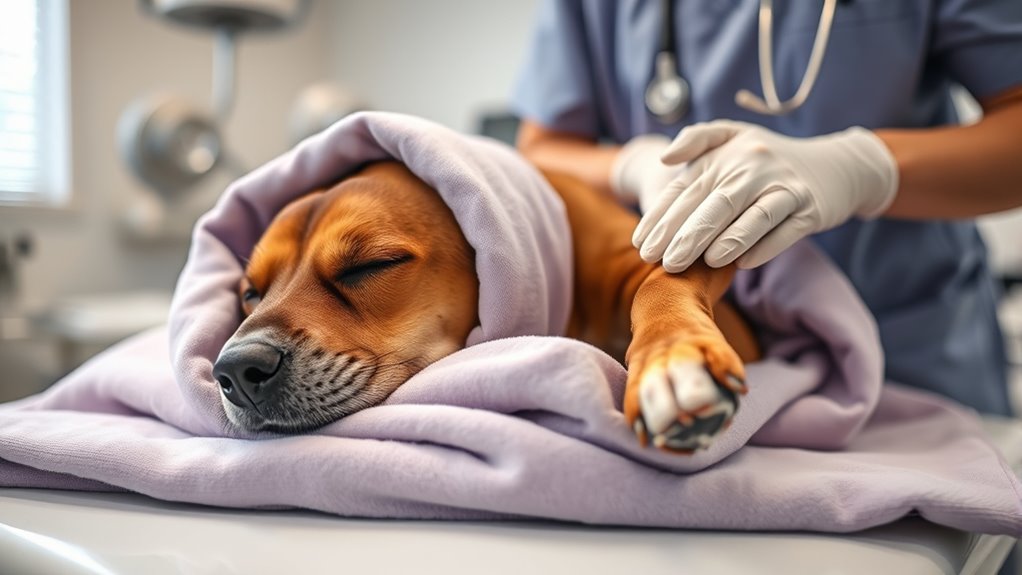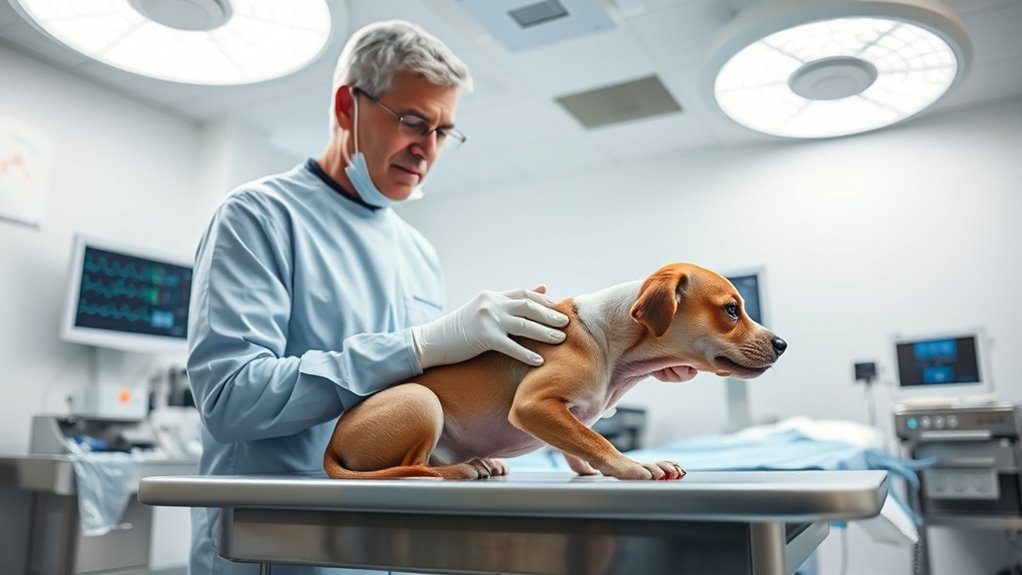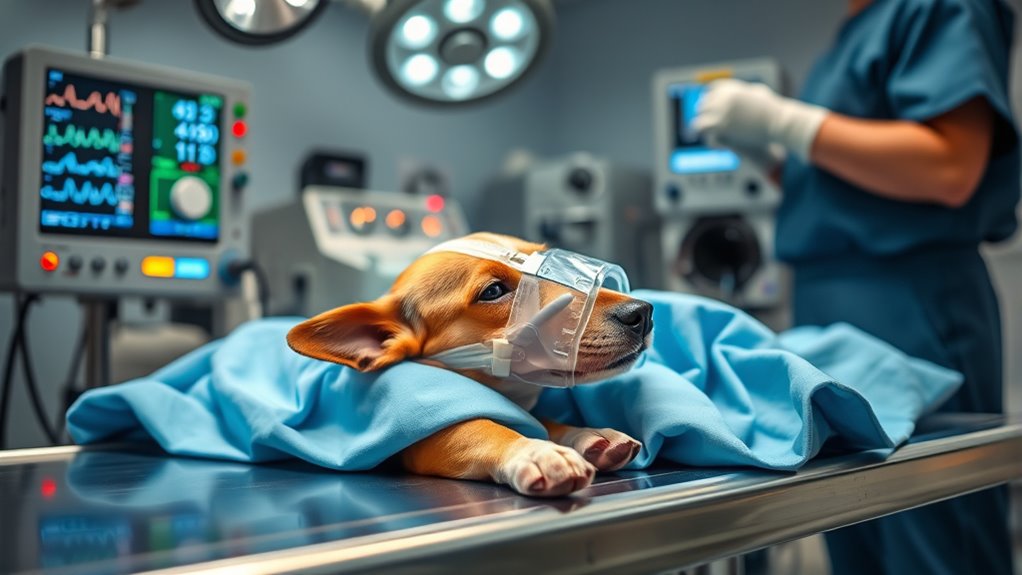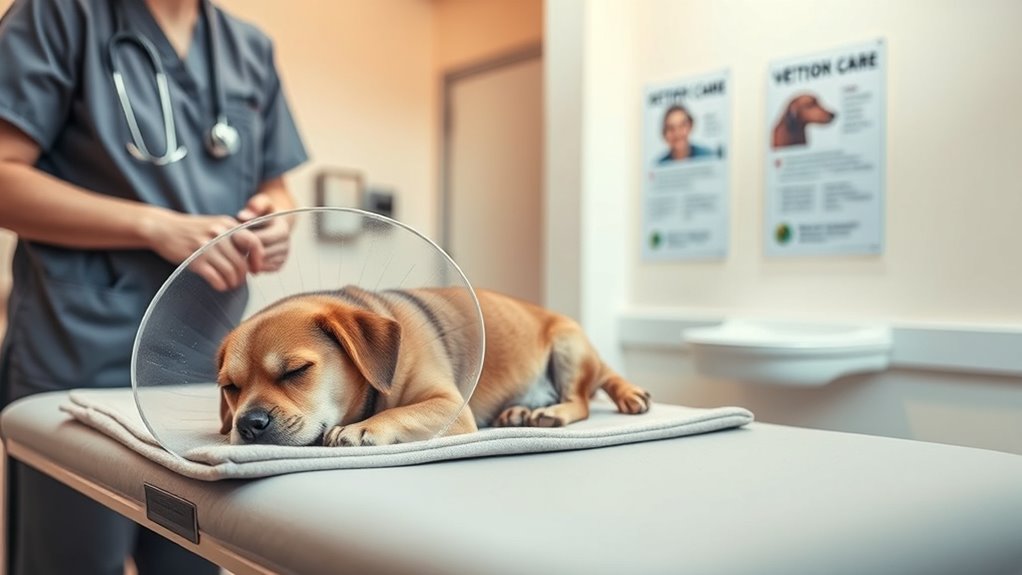If you’re preparing your pet for spaying or neutering, you’ll want to know what to expect before, during, and after surgery. Your pet will undergo anesthesia, be monitored closely, and recover in a calm environment. Watch for signs of discomfort, keep the incision site clean, and limit activity to support healing. With proper care, your pet’s recovery should go smoothly. To learn more on what to do at each stage, continue exploring essential post-surgery tips.
Key Takeaways
- Benefits include reduced cancer risks, behavioral improvements, and helping control pet overpopulation.
- Prepare by fasting your pet, confirming appointment details, and using a secure carrier for transport.
- Expect anesthesia with continuous vital sign monitoring and a smooth recovery in a quiet environment.
- Watch for signs of discomfort like swelling, redness, or excessive licking, and follow wound care instructions.
- Contact your vet if you notice persistent pain, bleeding, swelling, or unusual behavior during recovery.
Understanding the Benefits of Spaying and Neutering

Spaying and neutering your pets offer numerous health and behavioral benefits that can improve their quality of life. The benefits of spaying include reducing the risk of ovarian and uterine cancers, while benefits of neutering involve preventing testicular cancer and certain prostate issues. These procedures can also decrease unwanted behaviors like marking territory, aggression, and roaming, which keeps your pet safer. Spaying and neutering can help curb overpopulation and reduce the number of animals euthanized in shelters. Additionally, these surgeries often lead to a calmer, more focused pet, making daily life easier for you. Furthermore, recovery from these procedures generally involves minimal discomfort when proper post-surgery care is followed. Overall, understanding the benefits of spaying and neutering empowers you to make informed decisions that support your pet’s health, behavior, and long-term well-being.
Preparing Your Pet for Surgery

Preparing your pet for surgery is crucial to guarantee a smooth procedure and quick recovery. Start with a pre-surgery checklist to ensure your pet is ready—this includes fasting instructions, avoiding food or water if advised, and stopping medications if necessary. Confirm your appointment details and ask your veterinarian about any specific preparations. When it’s time to transport your pet, use a secure, comfortable carrier to reduce stress. Keep your pet calm and avoid sudden movements during the trip. Make sure the carrier is clean and familiar to minimize anxiety. Arriving on time and following all pre-surgery instructions will help your pet be as comfortable as possible and set the stage for a successful procedure. Additionally, understanding decoding slang can be helpful when communicating with pet owners or staff who may use informal language. Being aware of Relationships – Cheating Husband Secrets can also help you better interpret your veterinarian’s advice or concerns during consultations. Being informed about Practical Support options available in your area can further ease your pet’s post-surgery recovery process. It is also beneficial to review post-operative care guidelines to ensure proper recovery at home. Staying informed about veterinary advancements can help you understand new techniques that improve surgical outcomes.
The Day of the Procedure: What Happens at the Clinic

On the day of the procedure, you’ll bring your pet to the clinic at the scheduled time, ensuring they arrive rested and calm. Before leaving home, follow the clinic’s instructions on pre-surgery fasting—typically no food after midnight—to prevent complications during anesthesia. Once there, staff will confirm your pet’s details and begin anesthesia preparation. They might place a small IV catheter and monitor essential signs as part of the process. Your pet will be gently anesthetized, so they remain comfortable and pain-free throughout the procedure. The veterinary team will handle everything efficiently, minimizing stress for both you and your pet. Afterward, your pet will be moved to recovery, where they’ll be closely monitored as they wake up from anesthesia. It’s also important to remember that during recovery, monitoring your pet’s vital signs helps ensure a safe and smooth awakening.
Anesthesia and Monitoring During Surgery

During surgery, your pet’s safety depends on strict anesthetic protocols and continuous monitoring. Vets carefully track essential signs to guarantee everything stays under control. This attention helps prevent complications and keeps your pet comfortable throughout the procedure. Maintaining a balanced environment is also crucial for ensuring optimal anesthesia levels and patient stability. Using properly calibrated monitoring equipment further enhances safety and provides real-time feedback on your pet’s vital signs. Additionally, selecting an air purifier with HEPA filtration can improve the operating environment by reducing airborne contaminants, contributing to a safer surgical setting. Implementing advanced monitoring technology can detect subtle changes in your pet’s condition, allowing for prompt intervention if needed. Ongoing research into AI safety measures highlights the importance of rigorous safety protocols in high-stakes environments like veterinary surgery.
Anesthetic Safety Protocols
Ensuring anesthetic safety during spay and neuter surgeries is crucial for your pet’s well-being. Your veterinarian follows strict monitoring protocols to keep your pet safe throughout the procedure. These protocols include tracking vital signs like heart rate, respiratory rate, oxygen levels, and temperature. Anesthetic safety depends on careful dosing and constant observation to detect any signs of distress early. Your vet’s trained staff uses specialized equipment to monitor anesthesia depth and guarantee your pet remains stable. If any irregularities occur, prompt adjustments are made to keep your pet comfortable and safe. Rest assured, these protocols are designed to minimize risks and provide the highest level of care, giving you peace of mind that your furry friend is in expert hands.
Continuous Monitoring Techniques
Continuous monitoring techniques are essential for maintaining your pet’s safety throughout surgery, as they provide real-time data on vital signs and anesthesia depth. During the procedure, your veterinarian uses equipment to track vital signs such as heart rate, respiratory rate, and blood pressure, ensuring your pet remains stable. Monitoring oxygen saturation is equally critical, as it indicates how effectively your pet’s blood is carrying oxygen. If oxygen levels drop, adjustments can be made immediately to prevent complications. These techniques help detect early signs of distress or anesthesia overdose, allowing prompt intervention. By continuously observing vital signs and oxygen saturation, your veterinarian ensures your pet stays safe, comfortable, and properly anesthetized from start to finish. Additionally, fostering a digital-friendly environment can enhance communication and access to vital health information during the surgical process.
The Immediate Post-Operative Period in the Clinic

After a spay or neuter procedure, the immediate post-operative period in the clinic is critical for monitoring your patient’s recovery. During this time, you’ll observe for signs of post operative pain, ensuring the animal remains comfortable and responds appropriately to analgesics. Carefully check the surgical site for wound complications, such as swelling, bleeding, or discharge, which could indicate infection or improper healing. It’s important to keep the patient warm and quiet, minimizing stress and movement that could disrupt sutures or cause bleeding. Regularly monitor vital signs like heart rate, respiratory rate, and temperature to detect any early signs of distress. Prompt intervention at this stage helps prevent complications and promotes a smoother transition to full recovery.
Signs of Recovery and Normal Behavior at Home

Once your pet has returned home from surgery, you should observe for signs that they’re recovering well and returning to normal behavior. Look for behavior milestones like alertness, eating, and normal mobility. Mild signs of discomfort, such as licking or resting more than usual, can occur but shouldn’t persist. Monitor their activity levels and ensure they’re not overly lethargic or restless. The table below outlines typical signs of recovery:
| Behavior Milestones | Signs of Discomfort | When to Contact Vet |
|---|---|---|
| Returning to normal activity | Excessive licking or biting | Persistent lethargy |
| Eating and drinking | Swelling or redness at incision | Unusual aggression |
| Grooming and resting | Sudden refusal to move | Severe swelling or bleeding |
| Playfulness | Excessive hiding | Fever or vomiting |
Recognizing these signs helps you guarantee a smooth recovery. Additionally, proper post-surgery care is crucial for ensuring your pet heals quickly and comfortably, as monitoring activity levels can prevent complications during recovery. Regularly checking your pet for signs of infection such as foul odor or discharge can also aid in early detection of potential issues.
Managing Discomfort and Pain After Surgery

Managing discomfort and pain after surgery is essential to make sure your pet recovers comfortably and quickly. Proper pain management helps reduce stress and encourages healing. To achieve this, consider these steps:
Proper pain management after surgery ensures your pet recovers comfortably and promotes faster healing.
- Follow your vet’s instructions on administering prescribed pain relief medications.
- Keep your pet in a quiet, comfortable space to minimize stress and discomfort.
- Monitor your pet for signs of pain, such as whimpering or restlessness, and report concerns to your vet.
- Avoid giving human pain medications, which can be dangerous, and never skip doses without approval.
- Using appropriate sleep environments can also support your pet’s recovery by promoting rest and reducing anxiety.
Effective discomfort alleviation ensures your pet stays calm and pain-free during recovery, promoting a smoother healing process.
Wound Care and Activity Restrictions

To guarantee your pet heals properly, it’s important to carefully monitor their wound and control their activity levels. Proper incision care prevents infection and promotes healing. Keep the incision site clean and dry, checking for swelling, redness, or discharge. Limit activity to prevent stress on the stitches; avoid running, jumping, or rough play. Use the table below to understand specific restrictions:
| Activity Level | Allowed Activities | Restrictions |
|---|---|---|
| First 48 hours | Short, supervised walks | No running or jumping |
| 3-7 days | Gentle leash walks | Avoid vigorous play |
| After 1 week | Gradually return to normal activity | Keep an eye on incision site |
| Full activity | Resume normal routines | Follow vet’s advice |
Consistent wound care and activity restrictions ensure a smooth recovery. Additionally, minimizing noise and sudden movements can help reduce stress on the healing area, especially since noise levels of modern heat pumps are designed to be quieter and less disturbing during recovery periods. Being aware of angel numbers can also support a positive mindset during your pet’s healing process, fostering patience and hope. Recognizing the importance of compassion in veterinary care can further motivate you to provide gentle support throughout recovery.
When to Follow up With Your Veterinarian

Monitoring your pet’s wound closely is vital during recovery, but knowing when to check in with your veterinarian ensures everything is healing properly. You should follow up if:
- You notice swelling, redness, or discharge around the incision site.
- Your pet shows signs of pain, such as whimpering or refusing to move.
- There’s a persistent foul odor or bleeding.
- It’s time for routine vaccinations or if dietary considerations need adjustment post-surgery.
- Be aware that self-watering plant pots can help maintain consistent moisture, which is crucial for some post-surgical plants or herbs you may be caring for during recovery. Additionally, understanding local veterinary resources can ensure you receive prompt and specialized care if complications arise. Being familiar with emergency veterinary clinics in your area can be lifesaving in urgent situations. Regular check-ins help ensure proper healing and address any concerns early. Additionally, discuss any changes in diet or routine vaccinations with your vet, especially if your pet’s activity level needs modification during recovery. Staying vigilant and maintaining communication supports a smooth healing process, and consulting your vet about proper wound care techniques can further promote healing. Incorporating advanced fraud detection techniques into your pet’s post-surgery care plan may seem unusual, but it highlights the importance of using reliable tools and systems to monitor and safeguard your pet’s recovery process.
Frequently Asked Questions
How Long Does It Typically Take for a Pet to Recover Fully?
You might wonder how long it takes your pet to recover fully after surgery. Typically, post surgery healing takes about 10 to 14 days, but it varies depending on your pet’s age and health. During this time, you should follow activity restrictions closely to prevent complications. Keep an eye on the incision site, limit running or jumping, and ensure they rest so they heal smoothly and comfortably.
Are There Any Age Restrictions for Spaying or Neutering?
Ever wonder if your pet’s age matters? Yes, age restrictions and breed considerations can influence the timing of spaying or neutering. Usually, kittens and puppies are ideal, but some older pets can be safely done too. Breed considerations may vary, especially with larger dogs or certain breeds prone to health issues. Consult your vet to find the perfect timing for your pet’s age and breed, ensuring a healthy, happy future.
What Are the Risks of Complications During Surgery?
During surgery, you might worry about surgical complications and anesthesia risks. While these are rare, they can include bleeding, infection, or reactions to anesthesia. Your veterinarian takes careful steps to mitigate these risks by conducting pre-surgical assessments and monitoring your pet closely. Trust their expertise, follow pre-surgery instructions, and stay alert for any unusual behavior afterward to ensure a safe, smooth procedure.
Can My Pet Resume Normal Activities Immediately After Surgery?
You shouldn’t let your pet resume normal activities immediately after surgery. Exercise restrictions are essential to prevent wound complications and guarantee proper healing. Keep your pet calm and restrict vigorous play, running, or jumping. Follow your vet’s instructions for wound care carefully, checking the incision site regularly for signs of infection or swelling. Gradually reintroduce activity as advised, and avoid any activity that puts strain on the surgical area.
How Do I Manage Potential Behavioral Changes Post-Surgery?
Imagine your pet’s behavior as a gentle river, sometimes flowing smoothly, other times needing careful guidance. Post-surgery, you might notice behavioral adjustments—like increased clinginess or slight irritability. To manage these changes, observe patiently, providing comfort and consistency. Use gentle training strategies to reinforce positive behaviors. With understanding and patience, you’ll help your pet adjust smoothly, restoring harmony to your shared flow of daily life.
Conclusion
Think of spaying and neutering as planting seeds for a healthier, happier life for your pet. With gentle care and attentive follow-up, you’ll watch them blossom, free from worries and unnecessary burdens. This journey isn’t just about surgery—it’s about nurturing a lifelong bond rooted in love and responsibility. By guiding them through recovery, you’re watering a future full of joy, resilience, and endless adventures together.










